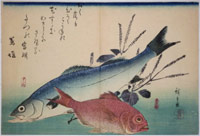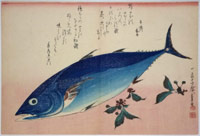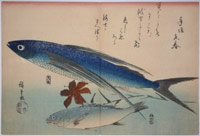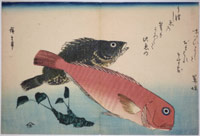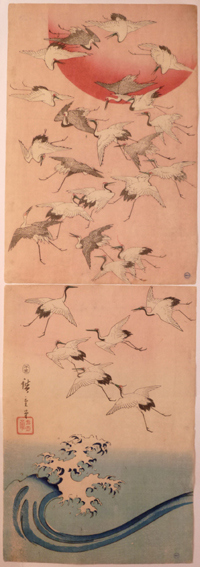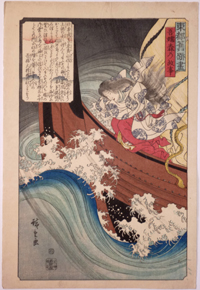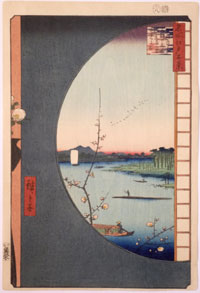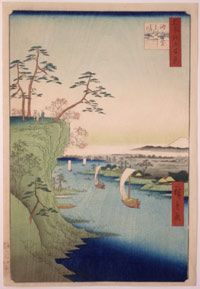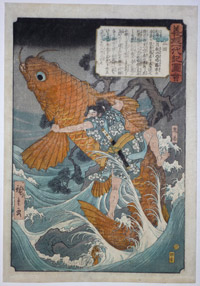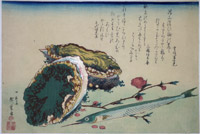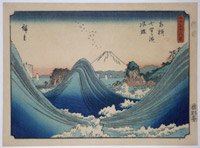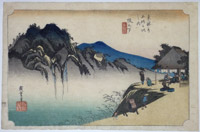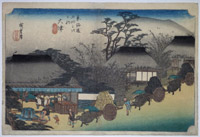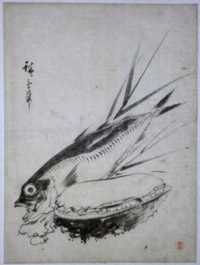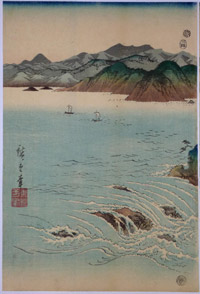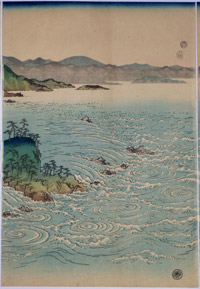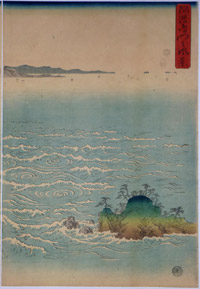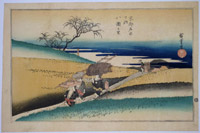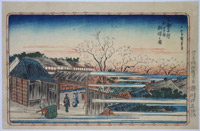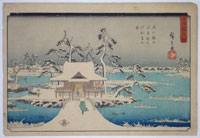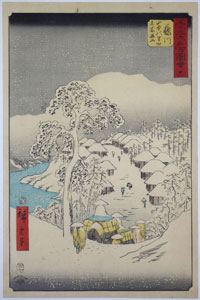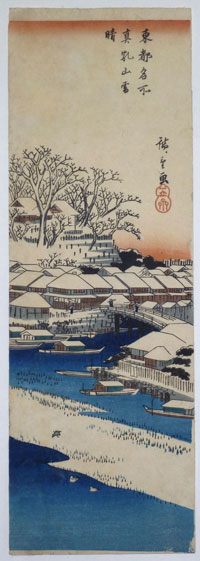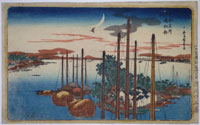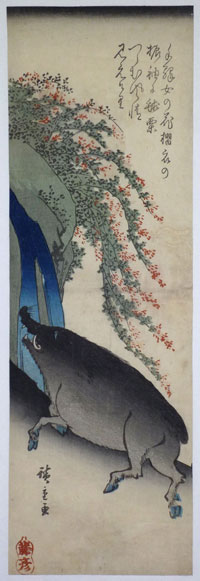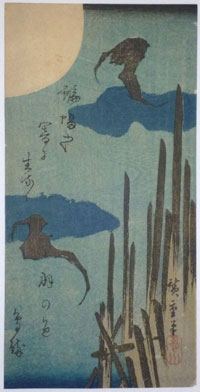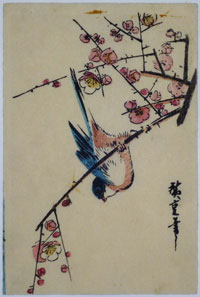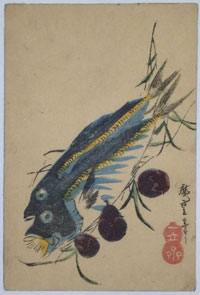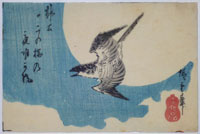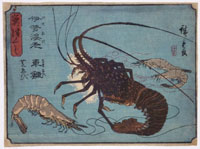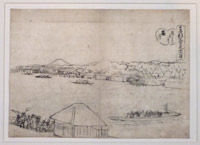Utagawa HIROSHIGE (1787-1858)
Click here to view image full size.
Suzuki, Japanese sea perch ( Lateolabrax japonicus ) and kaneme-tai, red bream ( possibly Beryx splendens ). With shiso or beefsteak plant. Poem by Atsugaki. From the second series of nine fish prints published c 1840 – 42 by Yamasho ( Yamadoya Shobei ). Ex collection Felix Bracquemond ( 1833 – 1914 ). Japonisme in France usually starts with Bracquemond who was a graphic artist and designer and also worked with ceramics. He discovered Hokusai’s Manga in 1856 and used it as source material. He produced a number of etchings, often of birds and some with fish, obviously partly inspired by Japanese prints, including Hiroshige’s prints. So, it’s reasonable to suppose these were the actual prints he used as inspiration. Bracquemond’s initial: “B” accompanied the prints.
Very good impression, colour and condition. Centre fold as per usual. Signed Hiroshige ga.
Status: Sold
Utagawa HIROSHIGE (1787-1858)
Click here to view image full size.
Katsuo, bonito ( Katsuwonus pelamis ). Also called ocean bonito, stripe-bellied bonito and striped tuna. Together with three sprigs of cherry ( sakura ). Poems by Toshinoto Haruki and Toshihiro Machikado. From the first series of eleven fish prints published c 1840 – 42 by Yamasho ( Yamadoya Shobei ). Ex collection Felix Bracquemond ( 1833 – 1914 ). Japonisme in France usually starts with Bracquemond who was a graphic artist and designer and also worked with ceramics. He discovered Hokusai’s Manga in 1856 and used it as source material. He produced a number of etchings, often of birds and some with fish, obviously partly inspired by Japanese prints, including Hiroshige’s prints. So, it’s reasonable to suppose these were the actual prints he used as inspiration. Bracquemond’s initial: “B” accompanied the prints.
Very good impression, colour and condition. Centre fold as per usual. Signed Hiroshige ga.
Status: Sold
Utagawa HIROSHIGE (1787-1858)
Click here to view image full size.
Tobiuo, flying fish ( probably Prognichthys ) and ishimochi also called guchi or shiroguchi, white croaker ( probably Argyrosomus argenatus ). Together with a single lily. Poem by Toshigaki Maharu. From the second series of nine fish prints published c 1840 – 42 by Yamasho ( Yamadoya Shobei ). Ex collection Felix Bracquemond ( 1833 – 1914 ). Japonisme in France usually starts with Bracquemond who was a graphic artist and designer and also worked with ceramics. He discovered Hokusai’s Manga in 1856 and used it as source material. He produced a number of etchings, often of birds and some with fish, obviously partly inspired by Japanese prints, including Hiroshige’s prints. So, it’s reasonable to suppose these were the actual prints he used as inspiration. Bracquemond’s initial: “B” accompanied the prints.
Very good impression, colour and condition. Centre fold as per usual. Signed Hiroshige ga.
Status: Sold
Utagawa HIROSHIGE (1787-1858)
Click here to view image full size.
Shiroamadai, white horsehead ( Latilus argentatus ) and omonhata, rock cod ( Epinephalus areolatus ). Together with Japanese horse radish, wasabi. Poem by Atsugaki. From the second series of nine fish prints published c 1840 – 42 by Yamasho ( Yamadoya Shobei ). Ex collection Felix Bracquemond ( 1833 – 1914 ). Japonisme in France usually starts with Bracquemond who was a graphic artist and designer and also worked with ceramics. He discovered Hokusai’s Manga in 1856 and used it as source material. He produced a number of etchings, often of birds and some with fish, obviously partly inspired by Japanese prints, including Hiroshige’s prints. So, it’s reasonable to suppose these were the actual prints he used as inspiration. Bracquemond’s initial: “B” accompanied the prints.
Very good impression, colour and condition. Centre fold as per usual. Signed Hiroshige hitsu.
Status: Sold
Utagawa HIROSHIGE (1787-1858)
Click here to view image full size.
A vertical diptych showing a multitude of cranes flying up from a cresting wave to a large red sun. In fact this diptych was used by an Edo publisher as end sheets to albums – usually sets of Hiroshige landscapes. Rare: Invariably it is impossible to match the two sheets as the bottom design is always graded blue at the top. Another matching impression is illustrated pl. 143 in Four Hundred Ukiyoe Woodblock Prints From The Museum Of Art, Rhode Island School Of Design, Abby Aldrich Rockefeller Collection Of Japanese Prints, 1990. Published 5/1858.
Fine impression and colour. Small expertly repaired binding holes, otherwise good condition. Collector’s seal bottom right on each sheet. Signed Hiroshige fude.
Status: Sold
Utagawa HIROSHIGE (1787-1858)
Click here to view image full size.
Azuma no Mori no koji “ The Old Story of Azuma” from a set Toto kyuseki tsukushi, “Old Edo Stories, Illustrated.” Exceptionally rare: Four other designs from the set came up at the Orange and Thornicraft sale, Sothebys, 25/3/1912, lot 440. And another impression of this design is illustrated in Hiroshige, The Albuquerque Museum, 1983, no. 722, pl. 74. Shows the concubine Tachibana Hime about to throw herself from the prow of the boat to appease the sea-gods and protect her lord Yamato Take. This she did despite him vowing to marry Miyazu Hime on his return. Published by Wakasa-ya, c 1845. A wonderful design.
Fine impression, colour and condition. Almost mint. Signed Hiroshige ga.
Status: Sold
Utagawa HIROSHIGE (1787-1858)
Click here to view image full size.
Masaki atari yori Suijin no mori uchikawa Sekiya no sata o miru zu, “View of Suijin Grove and Sekiya Village, Seen From Near Masaki” from Meisho Edo hyakkei, the “One Hundred Views of Edo” published by Uoei between 1856 and 1858 ( this being Snake 8, 1857 ). One of the great designs from the set, the view encapsulated by a semi-circular screen.
Superb impression of the first edition. Fine colour. One very small thinned spot, otherwise very good condition. Signed Hiroshige ga.
Status: Sold
Utagawa HIROSHIGE (1787-1858)
Click here to view image full size.
Konodai Tonegawa fukei, “View of Konodai and the Tone River” from Meisho Edo hyakkei, the “One Hundred Views of Edo” published by Uoei between 1856 and 1858 ( this being Dragon 5, 1856 ). Shows the river disappearing in the distance with Mt Fuji on the horizon. The scene being admired by three travellers on the rocky outcrop at left.
Superb impression of the first edition. Fine colour and condition. Signed Hiroshige ga.
Status: Sold
Utagawa HIROSHIGE (1787-1858)
Click here to view image full size.
Oniwakamaru, the young Benkei, battling with the giant red carp that swallowed his mother. From a set Yoshitsune ichidai zu. Of the utmost rarity: Stewart in Subjects Portrayed in Japanese Colour-Prints, Kegan Paul, 1922, p. 318, states that only one design ( not this ) was known at that time. It is unknown how many prints were designed for this set. Published c. 1845. A wonderful design and shows that Hiroshige could excel in other areas apart from landscapes.
Fine impression and colour. Slight discolouration in margins, otherwise good condition. Signed Ichiryusai Hiroshige ga.
Status: Sold
Utagawa HIROSHIGE (1787-1858)
Click here to view image full size.
Awabi or tokobushi, abalone or “sea-ear” and sayori, Japanese half-beak or snipe-fish, together with peach blossom from the first series of ten prints published by Eijudo, c. 1832-4.
Good impression. Very good colour. Slight creasing, otherwise good condition. Signed Ichiyusai Hiroshige ga.
Status: Sold
Utagawa HIROSHIGE (1797-1858)
Click here to view image full size.
The sea shore at Izu from the set Fuji sanjurokkei, the “Thirty-six Views of Mount Fuji.” The series published by Sanoya Kihei, 1852. This chuban set is now recognised as one of Hiroshige’s finest series and this is the best design. Late editions are not known which probably partly explains why the set was overlooked as it has always been rare. The heaving sea produces a wave that mimics the outline of Fuji.
Fine impression, colour and condition. Signed Hiroshige ga.
Status: Sold
Utagawa HIROSHIGE (1797-1858)
Click here to view image full size.
Sakanoshita fudesute mine, “The Peak of Fudesute Mountain from Sakanoshita.” Fudesute means to “throw away brush” which alludes to the story of the artist Motonobu Kano who, unable to capture the beauty of this view, threw his brush away. From the Fifty-three Stations of the Tokaido. The set published by Hoeido and Senkakudo, c. 1833-4.
Fine impression and colour. The seals very crisp. Very early impression: much better than the example in Ukiyoe Taikei. ( First edition ? ) Probably no other set went into so many reprints and there are a plethora of coarse impressions extant. Proof of how popular the designs were with the public. Indeed, it is stated that the first two hundred sets sold out in a matter of hours. Slight edge soil, otherwise good condition. Signed Hiroshige ga.
Status: Sold
Utagawa HIROSHIGE (1797-1858)
Click here to view image full size.
Otsu hashirii chamise, “The Running Well Teahouse at Otsu” from the Fifty-three Stations of the Tokaido. The set published by Hoeido and Senkakudo, c. 1833-4. Shows the teahouse with the eponymous well at far left. So-called because of the water that gushed from it. Rice cakes in Otsu borrowed the name and were called Shirii rice cakes. This is the extremely rare first state of the first edition with the mountain in the background ( missing on all later editions ) and gradation on the tea house roofs. Ukiyoe Taikei, vol. 14, no 54 shows the first edition but second state without gradation. Other first editions were in the Happer sale, Sothebys, 26/4/1909, lot 141 and Metzger auction, AA Galleries, NY, 13/11/1916, lot 157.
Fine impression with very crisp seals and the mountain beautifully graded in grey ( some impressions being in blue ). Probably no other set went into so many reprints and there are a plethora of coarse impressions extant. Proof of how popular the designs were with the public. Indeed, it is stated that the first two hundred sets sold out in a matter of hours. Fine colour. Slight thinning in centre with backing support and small repairs top and bottom margins, but generally very good condition. Signed Hiroshige ga.
Status: Sold
Utagawa HIROSHIGE (1787-1858)
Click here to view image full size.
An original Hiroshige brush drawing of an aji ( also muroaji ), horse-mackerel; awabi, abalone, and two ginger roots. On thin Japanese paper, 9 x 6.75 in, 22.9 x 17 cms. Beautifully signed Hiroshige hitsu. Probably a small present for a friend. Ex collections Hayashi ( seal bottom right ) and Oeder. Very good condition.
Status: Sold
Utagawa HIROSHIGE (1797-1858)
Click here to view image full size.
A view over the Naruto Strait of the whirlpools at Awa, Awa no naruto no fukei. Although no series title this is from a trinity of triptychs depicting Snow, Moon and Flowers, this being the last ( because the eddies and whirls were reminiscent of flowers [ nami no hana, “flowers of the waves” ] ). These were the last three great prints Hiroshige designed. All are rare, especially Snow and Moon. Published 1857 by Okasawaya Taheiji.
Fine impression. It is claimed that the first printings have a sliver of land on the far right horizon which is removed on later editions. However, there seems to be no discernable difference in quality between that state and very good impressions without. So, if true, this must have happened early on. Almost all impressions are without. Indeed, late impressions of this set of three triptychs are not known. Fine colour. Virtually untrimmed: These prints are extremely difficult to find without trimming, often well into the title cartouche. Signed Hiroshige ga.
Status: Sold
Utagawa HIROSHIGE (1797-1858)
Click here to view image full size.
The village of Yase, Yase no sato from Kyoto meisho no uchi, “Famous views of Kyoto.” Shows Oharame from the village of Ohara travelling to Kyoto to sell their wares. A set of ten prints published by Kawaguchiya Shojo, c 1834.
Very good impression and colour. Several expertly repaired wormholes, otherwise very good condition with large margins. Signed Hiroshige ga.
Status: Sold
Utagawa HIROSHIGE (1797-1858)
Click here to view image full size.
Shinyoshiwara asazakura no zue, “Morning Cherries at Yoshiwara” from Toto Meisho, “Famous Views of the Eastern Capital.” Hiroshige’s first landscape set of ten prints published c 1831 by Kawaguchiya Shojo. An early morning scene with low lying mist. A client takes leave of his companion.
Fine impression. The first edition with ochre patterned border. Missing on later editions. Fine colour. Thinned area top right border and minimal soil in right border. Large margins. ( The publisher’s name and address in right border is often trimmed off. ) Signed Ichiyusai Hiroshige ga.
Status: Sold
Utagawa HIROSHIGE (1797-1858)
Click here to view image full size.
The Benten Shrine, Inokashira Pond in a snowstorm, Inokashira no ike Benzaiten no yashiro no kei. One of a set Meisho setsu gekka, “Famous Places: Snow, Moon and Flowers.” ( The other two are Flowering Cherries at Kogamei and Autumn Moon at Takanawa. ) A fine and rare snow scene, this being the hard to get first edition with publisher’s seal Riuya Zenbei (?) left centre bottom. A later edition altered the seal to circular and moved it to the right border. An even later reissue was published by Marujin, his and the censor seal being in the left margin. This state had the sky block recut with heavy snowflakes and completely ruins the design. For this state see Japanese Prints & Drawings From The Vever Collection, Jack Hillier, Sothebys, 1976, no. 926, p. 950. Also Tamba, no. 223 ( later edition ) and Suzuki, no. 146 ( first edition ). Ex collection Walter von Scheven, 1878 – 1950, and purchased by him from R. Wagner, Berlin in 1921.
Fine impression and colour. Minor edge soil, otherwise very good condition. Signed Hiroshige ga.
Status: Sold
Utagawa HIROSHIGE (1797-1858)
Click here to view image full size.
Fujikawa from the so-called “Upright Tokaido.” One of the two snow scenes from the set. Published by Tsutaya, Hare 7, 1855. Ex collection Paul-Louis de la Noe, 1879-1919, ( an acquaintance of the Goncourt brothers, Bing and Hayashi ).
Fine, very early impression. Fine colour. Very good condition. Signed Hiroshige ga.
Status: Sold
Utagawa HIROSHIGE (1797-1858)
Click here to view image full size.
A chu-tanzaku view: Matsuchiyama-no yukihare, “Clearing Weather After Snow at Matsuchiyama.” From a set of at least 15 prints: Famous Places of the Eastern [ Edo] Capital.” Published c early 1830s by Fujihiko.
Very good impression, colour and condition. Signed Hiroshige ga.
Status: Sold
Utagawa HIROSHIGE (1797-1858)
Click here to view image full size.
Tsukudajima hatsu kakko, “The First Cuckoo at Tsukudajima Island” from Hiroshige’s first major landscape set of 10 prints with title Toto Meisho published by Shoeido c 1831-2. This is the rare first state: with ochre border; graded blue on water, and with the publisher’s name and address in right margin. Ex Ernest Le Veel collection. Sold Ader-Picard-Tajan, 24/10/1980, lot 96.
Fine impression and colour. Slight soil at left border. With the publisher’s name and address which is often trimmed on right, eg even the Pulverer impression pl 6, Hiroshige, Matthi Forrer, 1997. Very good condition. Signed Ichiryusai Hiroshige ga.
Status: Sold
Utagawa HIROSHIGE (1797-1858)
Click here to view image full size.
A chu-tanzaku showing a wild boar beside a waterfall. This was probably designed for a set of twelve zodiacal signs set. Other known prints from this group are: Ox, Dog, Hare, Tiger, Monkey and Horse. All are extremely rare. Indeed, I cannot locate another impression of this print. Published c 1830 by Fujihiro.
Fine impression. Restored wormhole centre right and slight centre fold. Otherwise good condition. Signed Hiroshige ga.
Status: Sold
Utagawa HIROSHIGE (1797-1858)
Click here to view image full size.
Evening with full moon and bats flying over irregular wood stacked in a timberyard. A well known print. One third block, 9.75 x 5 in; 25 x 12.5 cms. The only complete uncut example seems to be that illustrated in Four Hundred Ukiyoe Woodblock Prints From The Museum Of Art, Rhode Island School Of Design, 1990, no. 167, which shows the companion prints to be butterflies and wild grasses and tuna and white radish. Hiroshige designed another bat print, otherwise it?s a rare subject for ukiyoe. Ex collection Paul-Louis de la Noe, 1879-1919, ( an acquaintance of the Goncourt brothers, Bing and Hayashi ). Published c late 1830s.
Fine impression. Very good colour and condition. Signed Hiroshige hitsu.
Status: Sold
Utagawa HIROSHIGE (1797-1858)
Click here to view image full size.
A quarter-block, 6.5 x 4.25 in; 16.5 x 11 cms, print showing a titmouse perched on a cherry blossom branch. Published c late 1830s. Ex collection Paul-Louis de la Noe, 1879-1919, ( an acquaintance of the Goncourt brothers, Bing and Hayashi ). Probably unique.
Very good impression, colour and condition. Signed Hiroshige hitsu.
Status: Sold
Utagawa HIROSHIGE (1797-1858)
Click here to view image full size.
A quarter-block, 6.5 x 4.25 in; 16.5 x 11 cms, print showing two horse-mackerel and baby aubergines. Published c late 1830s. Ex collection Paul-Louis de la Noe, 1879-1919, ( an acquaintance of the Goncourt brothers, Bing and Hayashi ). Probably unique.
Very good impression, colour and condition. Signed Hiroshige hitsu.
Status: Sold
Utagawa HIROSHIGE (1797-1858)
Click here to view image full size.
A quarter-block, 4.25 x 6.5 in; 11 x 16.5 cms, print showing a cuckoo flying against a full moon. This bird is usually associated with the moon and is a harbinger of spring. Published late 1830s. Ex collection Paul-Louis de la Noe, 1879-1919, ( an acquaintance of the Goncourt brothers, Bing and Hayashi ). Probably unique.
Very good impression, colour and condition. Signed Hiroshige hitsu.
Status: Sold
Utagawa HIROSHIGE (1797-1858)
Click here to view image full size.
Sakana zukushi, A Fish Series, this design showing Ise-ebi, Kuruma-ebi and Shima-ebi, Lobster [ with roe ], Prawn and Shrimp. A half-block set of the utmost rarity. Indeed, this might be the only recorded example. One other design from the same set is illustrated in Hiroshige, The Albuquerque Museum, 1983, no. 327. Published c late 1830s. Ex collection Paul-Louis de la Noe, 1879-1919, ( an acquaintance of the Goncourt brothers, Bing and Hayashi ).
Fine impression and colour. Slight edge soil with small repairs to to top left and right corners, otherwise very good condition. Signed Hiroshige ga.
Status: Sold
Utagawa HIROSHIGE (1797-1858)
Click here to view image full size.
An original preparatory drawing for an unpublished set: Toto Fujimi junigatsu, “Mount Fuji Viewed from the Eastern Capital Through the Twelve Months”, this being Mutsuki. Sumi on paper, c. 1850-55, 9.5 x 13.75 in; 24.5 x 35 cms. Shows a full ferry crossing the Sumida. Slight soil and centrefold, but generally very good condition. Ex collection Beres, sold Paris 2002, lot 182.
Status: Sold
